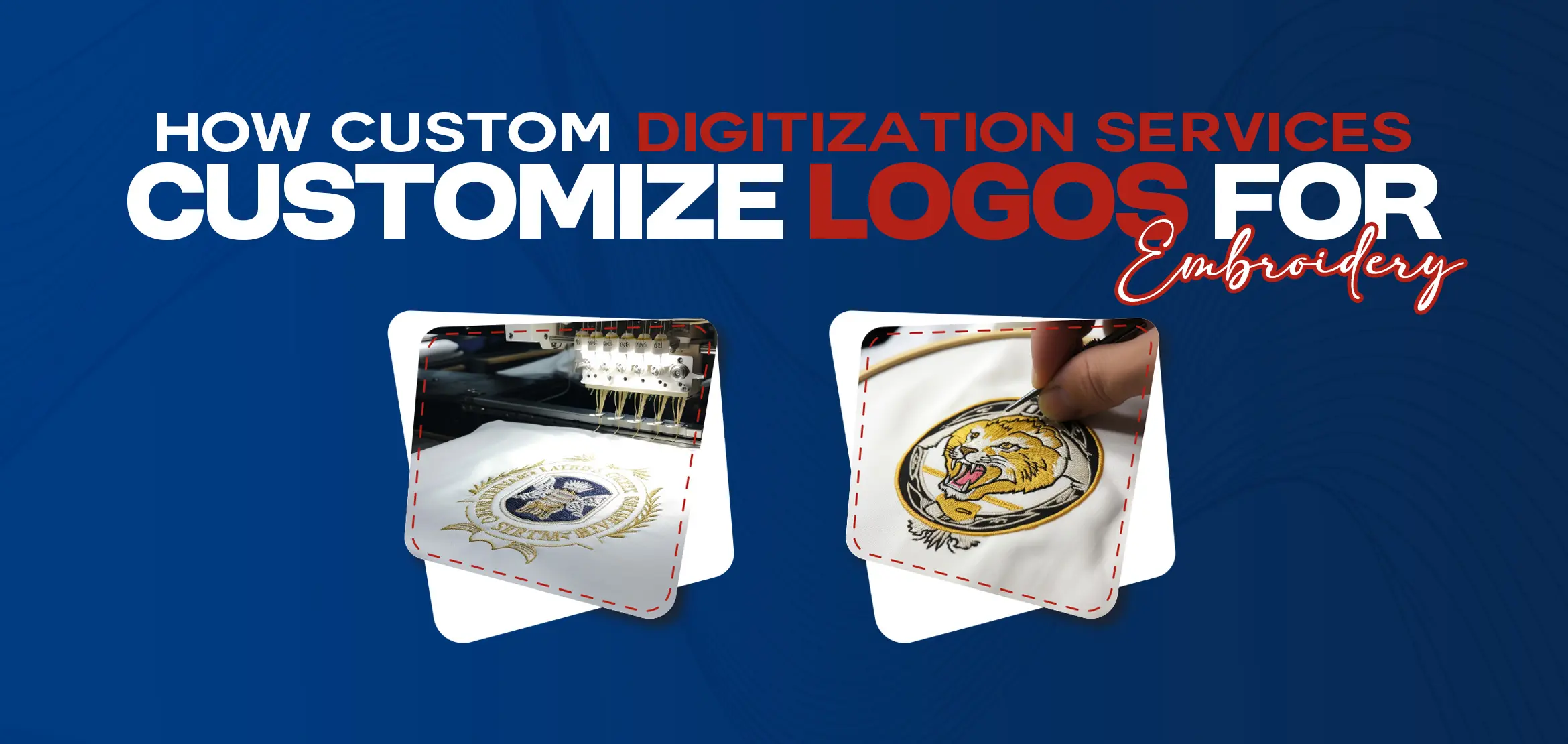
The Future of Custom Embroidery Digitizing in 2024
Table Of Content
- 1. Technological Advancements in Embroidery Digitizing
- 2. Impact of Artificial Intelligence on Digitizing Processes
- 3. Machine Learning Algorithms in Custom Embroidery
- 4. Integration of 3D Embroidery Technology
- 5. Sustainable Practices in Embroidery Digitizing
- 6. Customization Trends in 2024
- 7. Cross-Industry Collaboration
- 8. Augmented Reality in Custom Embroidery
- 9. Challenges and Solutions in Custom Embroidery Digitizing
- 10. Global Market Trends and Opportunities
- Conclusion
Embroidery, an age-old art form, is experiencing a renaissance in the digital age through the innovative realm of custom embroidery digitizing. As we embark on this exploration, let's delve into the roots of embroidery digitizing. Tracing its evolution from traditional craftsmanship to the cutting-edge technology that defines it today.
1. Technological Advancements in Embroidery Digitizing
In the dynamic landscape of the embroidery industry, technological advancements have emerged as the driving force behind transformative changes. The integration of state-of-the-art software and hardware has revolutionized custom embroidery digitizing. Offering designers unprecedented capabilities and pushing the boundaries of creative expression.
In the digital era, designers now wield sophisticated machines and intuitive software tools that enable them to achieve unparalleled precision and complexity in crafting intricate designs. The evolution of technology in this space promises a future where the artistry of embroidery converges seamlessly with the precision of digital innovation.
2. Impact of Artificial Intelligence on Digitizing Processes
Artificial Intelligence (AI) has become a game-changer in the realm of custom embroidery digitizing. In 2024, AI algorithms are not just enhancing digitizing processes, they are redefining them. These algorithms, fueled by machine learning, are capable of learning and adapting to the unique intricacies of each design.
The impact of AI extends beyond mere efficiency; it's about elevating the quality of embroidered creations. Designers can now leverage AI to navigate the intricacies of complex designs, resulting in a level of detail and accuracy that was once unimaginable. The symbiotic relationship between human creativity and AI precision is shaping the future of embroidery digitizing.
3. Machine Learning Algorithms in Custom Embroidery
Machine learning algorithms are at the forefront of the evolution of custom embroidery digitizing. These algorithms are not only streamlining the digitizing process but also evolving with each design iteration. The ability to learn and adapt ensures that the digitizing process becomes more efficient and tailored to the unique demands of each project.
In 2024, the synergy between machine learning and embroidery digitizing is evident in the speed and accuracy with which designs come to life. Designers can rely on algorithms to analyze and interpret design elements. Making the process more intuitive and reducing the margin for error. As we embrace machine learning, the future promises a more efficient and precise era for custom embroidery digitizing.
4. Integration of 3D Embroidery Technology
Embark on a journey into the third dimension of embroidery as 3D embroidery technology takes center stage. In 2024, designers are breaking free from the constraints of flat surfaces, ushering in a new era of creativity and tactile expression. The integration of 3D technology is redefining the very nature of embroidered art.
This cutting-edge technology allows designers to transcend the traditional boundaries of embroidery. Creating designs that not only captivate the eyes but also engage the senses. The interplay of textures and the depth of 3D embroidery technology open up endless possibilities for creating visually stunning and immersive designs.
5. Sustainable Practices in Embroidery Digitizing
In the wake of global environmental awareness, the embroidery digitizing industry is undergoing a paradigm shift towards sustainability. The shift towards eco-friendly materials and practices is not just a trend but a fundamental reevaluation of the industry's impact on the environment.
In 2024, the emphasis on sustainable practices is reshaping the choices made by designers and manufacturers alike. From utilizing biodegradable threads to minimizing waste, the custom embroidery digitizing industry is aligning itself with the principles of environmental responsibility. This commitment to sustainability not only meets consumer expectations but also positions the industry as a responsible steward of the planet.
6. Customization Trends in 2024
As we navigate the landscape of custom embroidery digitizing in 2024, the trend of customization emerges as a defining characteristic. The days of standardized designs are waning as personalized touches become the hallmark of embroidery. From bespoke monograms to intricate, one-of-a-kind patterns. The industry is witnessing a surge in demand for designs that reflect individuality.
In 2024, the customization trend extends beyond personal preferences; it's a celebration of uniqueness. Designers are embracing the challenge of translating individual identities into embroidered art, resulting in a rich tapestry of diverse and personalized creations. The future of custom embroidery digitizing lies in its ability to cater to the distinct tastes and preferences of each customer.
7. Cross-Industry Collaboration
The synergy between custom embroiderydigitizing and other industries is reshaping the creative landscape. In 2024, collaboration is not just a strategic move; it's a fusion of ideas and expertise that fuels innovation. From collaborations with fashion houses to partnerships with tech giants. The embroidery digitizing industry is integrating itself seamlessly into a diverse range of sectors.
This cross-industry collaboration is not only expanding the horizons of design possibilities but also influencing the trajectory of technological advancements. The exchange of ideas between industries is fostering an environment where creativity knows no bounds. The future promises a convergence of diverse influences that will redefine the very essence of custom embroidery digitizing.
8. Augmented Reality in Custom Embroidery
Step into a realm where reality intertwines with the virtual through the incorporation of Augmented Reality (AR) in custom embroidery. In 2024, AR is not just a novelty; it's a transformative tool that enhances the embroidery experience for both designers and customers alike.
AR technology enables customers to visualize embroidered designs in real-time. Allowing them to interact with and customize their creations before the first stitch is made. This immersive experience not only adds a layer of excitement for customers but also streamlines the design approval process. The integration of AR is bridging the gap between imagination and reality, offering a glimpse into the future of interactive and personalized embroidery.
9. Challenges and Solutions in Custom Embroidery Digitizing
Innovation is often accompanied by challenges, and the world of custom embroidery digitizing is no exception. As technology advances and new trends emerge, designers and manufacturers face obstacles that require innovative solutions.
One of the primary challenges is the need for continuous upskilling in response to rapidly evolving technologies. Designers must stay ahead of the curve, familiarizing themselves with the latest software and machinery to harness the full potential of digitizing advancements. Additionally, ensuring the compatibility of designs across various platforms and machines poses another challenge.
However, the industry's resilience lies in its ability to overcome challenges through innovation. Training programs and collaborative platforms are becoming essential components of the solution. As the industry collectively addresses these challenges, it paves the way for a future where custom embroidery digitizing remains at the forefront of creative expression.
10. Global Market Trends and Opportunities
The global landscape of custom embroidery digitizing is dynamic, with trends and opportunities constantly evolving. In 2024, businesses and entrepreneurs navigating this landscape must be attuned to the latest developments to capitalize on emerging opportunities.
One prominent trend is the growing demand for personalized and artisanal products. Consumers, now more than ever, seek unique and customized designs that reflect their individuality. This shift in consumer behavior presents an opportunity for businesses to differentiate themselves by offering tailored and bespoke embroidery services.
Additionally, the rise of e-commerce and online marketplaces has expanded the reach of custom embroidery digitizing businesses. With a global audience at their fingertips, businesses can explore new markets and connect with customers worldwide. The key lies in embracing digital platforms and leveraging them to showcase the uniqueness of custom embroidery designs.
Conclusion
In conclusion, the future of custom embroidery digitizing in 2024 is a tapestry woven with threads of innovation, creativity, and technological advancements. From the integration of AI and machine learning to the exploration of 3D embroidery and augmented reality. The industry is at the forefront of a transformative era.
Sustainability and customization are not just trends but guiding principles that will shape the industry's trajectory. Cross-industry collaborations will continue to break down barriers, fostering a rich exchange of ideas and influences.
As designers and businesses navigate the challenges and opportunities presented by the evolving landscape, one thing is certain. The canvas of custom embroidery digitizing is vast, and the potential for creativity is limitless. The future beckons with a promise of continued growth, innovation, and a reimagining of what is possible in the world of custom embroidery digitizing.
FAQs (Frequently Asked Questions)
Q1. How has technology influenced custom embroidery digitizing?
Technology has revolutionized custom embroidery digitizing, enabling designers to use sophisticated machines and intuitive software tools for unparalleled precision and complexity in crafting intricate designs.
Q2. What is the impact of Artificial Intelligence on digitizing processes?
Artificial Intelligence (AI) algorithms, powered by machine learning, are redefining digitizing processes by enhancing efficiency and elevating the quality of embroidered creations through adaptive learning to unique design intricacies.
Q3. What is the role of machine learning algorithms in custom embroidery digitizing?
Machine learning algorithms streamline the digitizing process, adapting with each design iteration in 2024. This synergy between machine learning and embroidery digitizing results in a more efficient and precise era, reducing the margin for error.
Q4. How is 3D embroidery technology changing the nature of embroidered art?
In 2024, the integration of 3D embroidery technology is allowing designers to transcend traditional boundaries, creating visually stunning and immersive designs that engage not only the eyes but also the senses.
Q5. What is the industry's approach to sustainability in custom embroidery digitizing?
In response to global environmental awareness, the custom embroidery digitizing industry is shifting towards sustainability in 2024, embracing eco-friendly materials and practices, aligning itself with environmental responsibility principles, and meeting consumer expectations.










